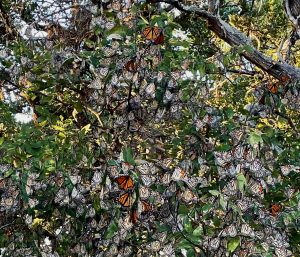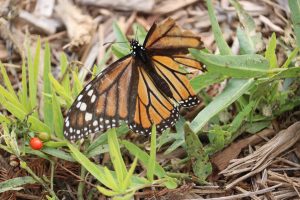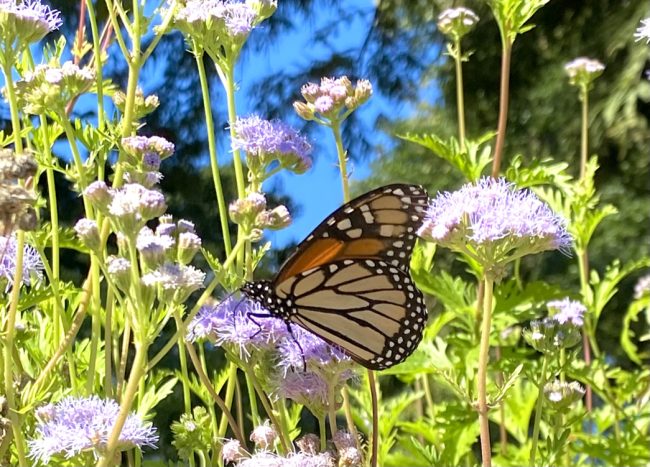Day of the Dead/Dia de los Muertos has come and gone, but numerous sightings of monarch butterflies continue in and around San Antonio and the Texas Hill Country.
Typically the iconic orange-and-black creatures migrate through what’s known as the “Texas Funnel” in mid-to-late October, completing their annual multi-generation migration in Mexico by the first few days of November in time for celebrated Mexican holiday that honors those who have died. But this year the migration appears extended.
East of the Rocky Mountains where the monarch population migrates to Mexico, numbers have been strong all season. And in central and south Texas monarchs continue to move south into mid November–especially along rivers or in landscapes where late season flowers offer nectar for fueling the butterflies’ long flight to their winter roosting sites in Mexico.
“It is again long and late,” said Cathy Downs of Comfort, Texas.
Downs has witnessed many monarch seasons in her time as a monarch butterfly conservation specialist for citizen science organization Monarch Watch, which tracks the butterflies’ migration each fall. Throughout October she’s witnessed dozens of monarch butterflies at local parks in Kendall County, where peak monarch migration occurs in mid-late October.
But then on October 30, Downs was alerted that an estimated 1,200 monarch butterflies were roosting in Burnet, Texas, in the middle of a group of homes near Lake Buchanan.
“I was surprised by the size of the roost,” said Downs, adding that she traveled to Burnet to help tag the butterflies, but they dispersed quickly. Warm temperatures in the northeast this fall appear to be holding large numbers of monarchs back.

This roost of an estimated 1,200 monarch butterflies was photographed on Oct. 29 in Burnet, Texas, near Lake Buchanan. Credit: Courtesy of Jack Marshall
Juan Guerra, senior horticulturist for the City of San Antonio, said he’s noticed a difference in the migration this year.
“Monarchs came more in waves since late July rather than a mass migration in the fall and you can still see them today feeding from our nectar plants in our River Walk pollinator gardens,” he said.
This late presence of monarch butterflies is not just happening in Texas.
Don Davis, a long time monarch butterfly follower in Ontario, Canada, where the multi-generation autumn migration begins, reported via the DPLEX, an email list for monarch butterfly enthusiasts, that monarchs were spotted in Point Pelee, Ontario, on November 8.
“These sightings are uncommon,” said Davis. “Most regions of Ontario have now had their first frosts, but a few monarchs seem to survive overnight, possibly finding a sheltered spot or microhabitat in which they survive.”
Out on the West Coast, where a separate population of monarch butterflies migrates up and down the California coastline, the news has also been upbeat. Numbers of the iconic creatures plummeted to near extinction last year, to less than 2,000. But now the insects have rebounded handsomely–despite drought, wildfires and the recent cyclone bomb storm.
“It’s a hopeful sign that we are seeing better numbers and the migration is definitely not gone, as some feared after last year,” said Emma Pelton of the Portland, Oregon-based Xerces Society, an invertebrate conservation protection organization that filed a petition to have monarch butterflies listed as “threatened” under the Endangered Species Act in 2015. US Fish and Wildlife Service denied that status last December, but ruled threatened status was “warranted but precluded,” and will revisit the issue in the future.
Even though the recent uptick is good news, Pelton said it does not constitute a population recovery. “If this was four years ago, we would actually be quite concerned with how low the numbers are. It’s really important not to get used to a new baseline and forget that we had hundreds of thousands of monarchs in the 2000s and 2010s and over a million monarchs in the 20th century.”
Karen Oberhauser, founder of monarch butterfly citizen science organization Monarch Joint Venture and professor at the University of Wisconsin-Madison, said she’s cautiously optimistic about the good news from monitoring summer breeding activity and anecdotal reports of high numbers seen during the fall migration. “I hope…it translates into good numbers in Mexico,” she said. She added that the news from California is “incredibly exciting.”

Ragged monarch butterfly rests on Antelope horns milkweed at Confluence Park along the San Antonio River November 9, 2021. Photo by Lee Marlowe
Chip Taylor, founder of Monarch Watch, was less enthusiastic, and suggested that the eastern monarch migration population will decline this year.
He cited drought conditions in the Dakotas making for less breeding, and added that historically late migrations make for smaller overwintering populations. “As to the East, numbers are down and the overwintering population numbers will be substantially lower this year.”
Scientists like David James, an entomologist at Washington State University who studies the California population, sees a hopeful future of mixed monarch populations. As the climate continues to warm, some will migrate, and others will stay put. “The proportion and population sizes of these will shift annually according to temperatures particularly during Sept-Oct,” he said.
Another reason for optimism on the monarch butterfly front: the recently passed infrastructure bill, which awaits President Biden’s signature, includes the Monarch and Pollinator Highway Act of 2021.
The Act will provide for $2 million annually from 2022-2028 for grants available to states, Indian tribes, and federal land management agencies. The Act specifies grants will be awarded to carry out pollinator-friendly practices on roadsides and highway rights-of-way, including the planting and seeding of native, locally-appropriate grasses, wildflowers, and milkweed.
TOP PHOTO: Monarch butterfly nectars on Gregg’s purple mistflower in front of the San Antonio River Authority along the San Antonio River November 8., 2021. Photo by Monika Maeckle
Related posts:
- Monarch Butterfly and Pollinator Festival takes flight from new roost at Confluence Park
- Massive arrivals of monarch butterflies signal 2021 migration is on
- Katharine Hayhoe: for productive climate change talk, find common ground
- Get your wings on for the month-long Monarch Butterfly and Pollinator Festival
- “Things look good” as 2021 monarch butterfly migration takes flight
- Save the date for the 2021 Monarch Butterfly and Pollinator Festival at Confluence Park
- Two monarch butterflies tagged on the Llano River in honor of lost loved ones recovered
- FREE Festival webinars available: Butterflies, bats, bees and metamorphosis
- Documentary chronicles year of chaos through the lens of the monarch butterfly migration
- Doug Tallamy proposes crowdsourcing a homegrown national park: Who’s in?
- Paddling Lessons: documentary reveals the secret life of a river
- A monarch at my Abuela’s Day of the Dead altar
- Monarch Butterfly and Pollinator Festival to remember those lost in 2020
Like what you’re reading? Don’t miss a single article from the Texas Butterfly Ranch. Sign up for email delivery at the bottom of this page, like us on Facebook, follow us on Twitter, @monikam or on Instagram.


Thanks for all you do i soooooo appreciate yall
Thank you for reading and writing. —MM
Flutter by beautiful butterfly

Love u lots butterfly
The western US overwintering population along the California coast has actually had the most spectacular rebound – percentage wise – in it’s history – rising from a Thanksgiving Count of only about 2,000 butterflies last winter to what is obviously going to be 100,000+ butterflies counted this year = 50+ TIMES as many butterflies! Unprecedented. The previous one year rebound in the West was about 10 times as many butterflies in the fall-winter of 1995-96 at the coastal overwintering sites as compared to 1994-95.
To me, I believe the eastern overwintering count may be slightly lower than last year because the early-mid October numbers passing through west Texas (Junction to Ozona area) were slightly lower, but still pretty high as this early October video at Sonora, Texas shows.
The late October and early Nov numbers moving through the low altitude foothills west of Austin & San Antonio, however, were higher than last fall. So the overwintering sites located in the eastern edges of the overwintering range in central Mexico might have similar or greater numbers of monarchs than last year; e.g. the Palomas & Oxtotilpan colonies southwest of the city of Toluca and especially the Popocatepetl volcano colony east of Mexico City.
It’s all of us who have discovered how great growing Milkweed is!!!! LOL i have 200 plus plants in my yard from 5 plants i bought from a nursery 2 years ago. I fed friends caterpillars with “come cut” milkweed they harvested from my backyard. I just love seeing the MOnarchs come into my yard as if they followed a map to my crop. LOL ANd i noticed the late monarchs, as the article mentions for TX. lana grossman, Katy TX
You could send sone my way. I can’t afford the price.
I know neighbors who’d love any blooming plants. Low incone housing and mainly dirt with weeds.
So dismal and depressing.
We still have Monarchs passing through our place as of 11,11,2021… We have many frost plants that recovered after the recent very dry spell and are attracting the Monarchs passing by…
I forgot, our place is surrounded by Belton, Texas…
6-8 monarchs still around west of marble falls . Good moisture allowed milkweed growth this year. Many monarch caterpillars up till 2 weeks ago.
I have about 5 or 6 in my yard right now, plus about 10 chrysalis and quite a few caterpillars. Cut back about 50 milkweeds and moved cats found to some milkweeds left for them. I thought they were the same butterfly’s hanging out but I marked them and to my surprise they are not, they seem to move thru after a few days but do leave eggs – don’t think they are still leaving eggs but some do chase each other around like there are mating – who knows.
FYI – Location Humble TX
I gave a program todayto a garden in Longview on the Monarchs and Catalina Trail. Is she still active with Texas Butterfly Ranch?
Bonny Edmonds
Not that I’m aware of.
I saw one yesterday 11/ 14 l 2021 in yucca valley california she was flying around yellow blossom of a desert bush
Really enjoyed your articles & comments about the monarchs. Glad to hear they are rebounding. I plan to do more to help. Thanks again for the insightful updates.
Have caterpillars on my milkweed, hope it doesn’t get cold soon. Dallas/Ft. Worth area
Hi Monika! We have found 6 caterpillars on our milkweed in the garden and brought them inside today (November 18) in a butterfly habitat. I’m reading up on what to do…..my 3 year old Granddaughter is thrilled!!
Your old pal Jenny in Nacogdoches!
Here’s my theory and it would require investigation, but for most of 2020 auto traffic was dramatically reduced, so the millions of monarch butterflies killed by cars did not occur. That meant millions more made the migrations all year to reproduce. What makes me think there is a correlation is the fact that I have seen greater numbers of all species this year. Now, it could be that more people are becoming aware and planting more milkweed, but who tracks that?
I just happened to be outside yesterday, December 30, 2021, when I spotted a large monarch in my milkweed. I checked the milkweed and sure enough there were eggs. It’s been super warm so far but supposed to get cold in a couple of days. I brought some of the eggs in. I have heard that the late butterflies can be sick with OE. Should I discard the eggs or try to raise them? I’m in Spring/The Woodlands, TX. Thank you for your help!
I read reports about the large increases in Monarch populations and other butterflies from 2020 to 2021. Completely anecdotal observation, but in 2020, vehicle traffic was dramatically reduced the entire year. Living in Driftwood, TX, I can tell you that you can hit butterflies with your car frequently and often unavoidably. That one factor alone had to substantially contribute to millions of butterflies surviving the entire migration cycle from Mexico and back again in 2021. As people move into the suburbs and things normalize, this can go the other way because traffic in more suburban and rural areas will increase hazards to butterflies and other flying insects.